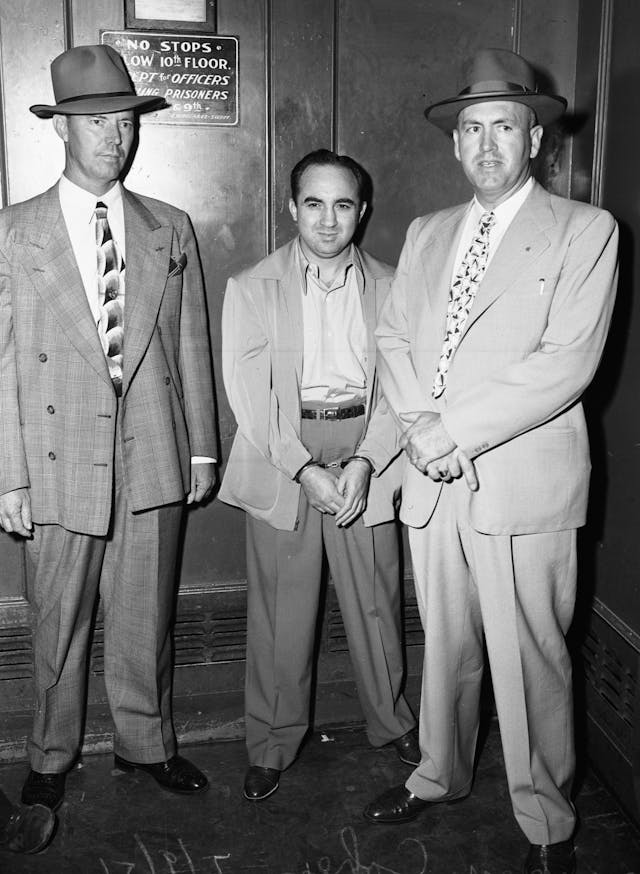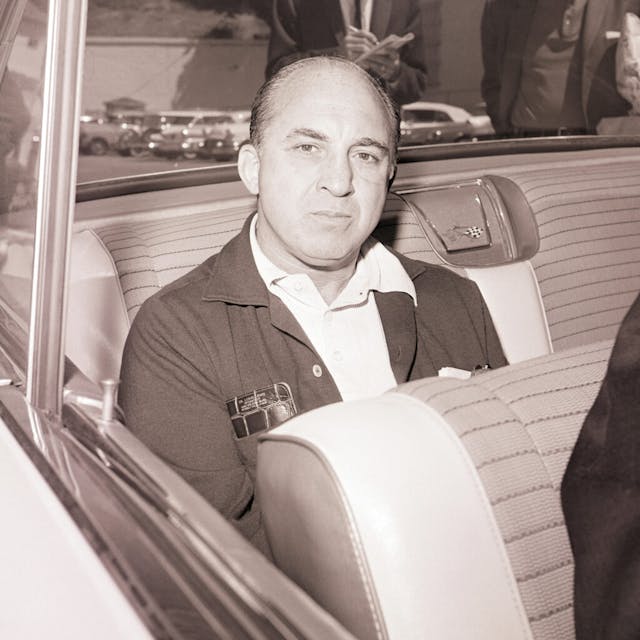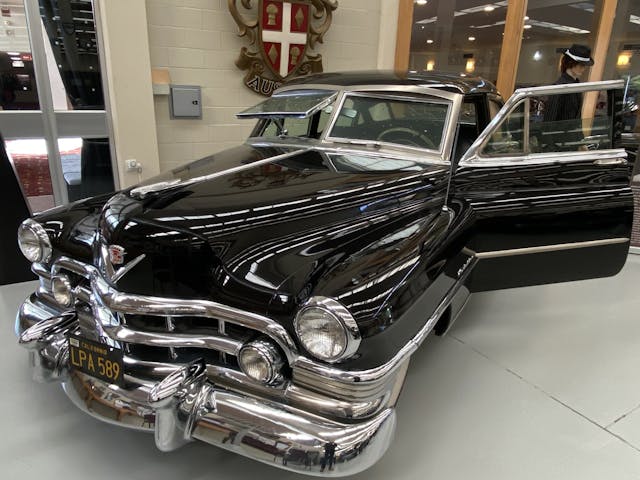When L.A.’s most notorious gangster built a bulletproof Cadillac
McAleer made a fun choice with tone here, and we salute it. Read this story aloud in your best 1940s film-noir melodrama voice—the more Maltese Falcon sass you add, the more fun you’ll have with it. —Ed.
The shots rang out at 3:55 in the morning—attempted murder on the Sunset Strip. It was July 19, 1949. Special agent Harry Cooper took two in the stomach, Dee David got hit in the back, and Neddie Herbert got a bullet in the side. Neddie didn’t make it. Everyone else lived, including the fourth wounded, a gangster with two slugs in his shoulder.
When Mickey Cohen walked out of the hospital a few days later, he knew they’d try again. So he made a call about a Cadillac.
He was born Meyer Harris Cohen, in New York City, in 1913. Cohen’s parents could not have known their son would become a key figure in the Los Angeles underworld, but the boy was a bad seed from the get-go. At nine, he was sent to reform school for “persistent thievery.” At the tender age of 15, the young Cohen fancied himself a boxer, so he went to Cleveland to fight. He took his nickname there, to sound more like an Irish prizefighter and get on fight cards easier.
Cohen wasn’t a great boxer, but he wasn’t a bad one, either. He was a fireplug, just five-foot-five, a bulldog in the ring. Half the time he lost it was only because some palooka had knocked him out. He fell in with a criminal element, guys with names like Moe and Lou. When he moved to Chicago, he met Al Capone, Public Enemy Number One, the most famous criminal in the country. After the FBI put America’s gangster-in-chief away for tax evasion, Cohen began working as an enforcer for Capone’s crime family. When threats from a rival forced him to skip town, he tried Cleveland for a bit, then lit out for the west. When Cohen hit L.A. in 1939, the town didn’t know enough to do the smart thing and hit back.

Hollywood’s noir period was rooted in true stories of the local underworld: bent cops, illicit card games, shootouts between rival bookies—the crime was out in the open, and half the time, on the Strip itself. Cohen became the Capone of California, a legend later played on-screen by the likes of Harvey Keitel, Paul Guilfoyle, and Sean Penn.
In 1949, when that heater put those bullets in his shoulder, Cohen was deep into a war with mafia kingpin Jack Dragna. When the east-coast syndicates came to town, chiefed by the notorious Bugsy Siegel, Dragna was all wet, shoved out of power. The hoods from the east and the hoods from the west held an uneasy alliance for a few years, and then, in ’47, Siegel got fitted for a Chicago overcoat. Cohen took over, but he refused to be Dragna’s goon.
Some believe Dragna ordered Cohen’s blood spilled on Sunset. In truth, that hospital visit was courtesy the L.A. police, a group of crooked cops trying to keep Cohen from ratting them out. Because a man like Cohen always has more enemies than friends, he knew it was time to buy a car.

In the summer of 1950, a small L.A. shop named Coachcraft Limited got a call from a local Cadillac dealer. Coachcraft had built armored cars for foreign dignitaries, but this build was different—this dealer’s customer wanted his new Sixty Special bulletproof. A week later, Cohen showed up at Coachcraft, nattily dressed as always, to sketch out his needs: looks as stock as possible, plus more toughness than the standard armored car. Where traditional car armor would repel a .45-caliber slug, our man wanted to stop a .38-cal armor-piercing shell.
Coachcraft got to work. Materials were tested at the L.A.P.D.’s firing range. Two-inch thick laminated glass was ordered. The entire passenger compartment was armored. All told, the work totaled 1500 man-hours and added 2000 pounds to the car’s 4000-pound heft. When they were done, they painted it a dark navy blue, like the night.

Al Capone had an armored Cadillac, a ’28, but that car never got a chance to stop a shot. Cohen’s joined the club. His Sixty was so heavy that a special permit was required to drive it on the highway, a permit Cohen couldn’t have. Meanwhile, in the U.S. Senate, the Kefauver commission had begun to dig in on organized crime. Cohen found himself hauled in. He testified alongside dirty men like Meyer Lansky, Frank Costello, and the associates of Atlantic City’s notorious Nucky Thompson.

The feds convicted Cohen on tax evasion in 1951, then again in 1961. He did prison stints for each charge, and in 1972, when he left the penitentiary for good, he went on TV talk shows, cheeky and colorful. Four years later, when the criminal in America’s living rooms died of stomach cancer, his armored Cadillac was still at large.
One account has Mickey selling it to a Texas oilman. The car was more likely confiscated by the Los Angeles police. But the strangest truth of all is where Cohen’s Cadillac now rests, some 6600 miles away from the City of Angels, in a museum in Otaihanga, New Zealand.
Information is thin on the Caddy’s arrival there. Car collector Sir Len Southward acquired Cohen’s Sixty for his car museum, but he died in 2004, and he mostly kept his files in his head.

Regardless, Southward seems to have been a generally brave and decent person. He raced and set records with speedboats and motorcycles, and he was knighted for charitable work, helping children with disabilities. That such a man would buy and preserve the car of a notorious gangster is indicative of eclectic taste. Southward’s museum also houses the only DeLorean DMC-12 in New Zealand, a V-16 Cadillac once owned by actress Marlene Dietrich, an early Stutz Indy car, and a three-wheeled Davis Divan.
It’s a long flight from Los Angeles to New Zealand, a long way to see a relic of the days when Sunset Boulevard was a battleground. Or rather, the first days. The spot where Cohen was plugged, the spot that set him on the path to building that Cadillac, would see violence again. In 2014, an unknown gunman shot and wounded hip-hop mogul Suge Knight six times at a nightclub at the same address—9039 Sunset Boulevard.
Seventy-four years after Cohen walked out of that hospital, there is still Hollywood, still palm trees, still beaches and tourists. And still danger under the gloss. Except once, when you ran with a tough crowd, you brought a Cadillac nearly 19 feet long, and you tried to blend in.
Check out the Hagerty Media homepage so you don’t miss a single story, or better yet, bookmark it.



On the roof of the building in the first photo, doesn’t the lettering look exactly like the font of PING golf clubs?
MAN, is ‘dat some sweet cah!
Meself, I had a 1957 Coupe de Ville; and boy, did it toin heads.
Maybe you should check da history on yours, since I ain’t so sure ’bout some of ‘dem dates.
Now, I was a 2nd Generation of the Old Country, but all my relations was strictly above-board, though they couldn’t help but know some of the neighborhood Characters. (Seriously, a few locals were among those who “rode the lightning” up in Ossining.
Youse suggested dat dis was read in some propah-sounding voice.
I volunteer, if youse is lookin’ for a propah readin’.
Great story — great car — terrible people.
You nailed it, brother.
MAN, is ‘dat some sweet cah!
Meself, I had a 1957 Coupe de Ville; and boy, did it toin heads.
Maybe you should check da history on yours, since I ain’t so sure ’bout some of ‘dem dates.
Now, I was a 2nd Generation of the Old Country, but all MY relations was strictly above-board, though they couldn’t help but know some of the neighborhood Characters. (Seriously, a few locals were among those who “rode the lightning” up in Ossining.)
Youse suggested dat dis be read in a propah-sounding voice.
I volunteer, if youse is lookin’ for a propah readin’.
Great story — great car — terrible people.
I still own and can almost fit into my dad’s Mickey Cohen original zoot suit that he and my mom bought at Mickey’s “legitimate” men’s clothing store in L.A. in the 40’s. Story has it that 2 of his “goons” opened the door for them to enter the store.
Just turned 74. years pass by pretty quick. grew up on the west side of LA. My mother and I lived in a small bungalow. Money was tight. I had learned to drive at the age of nine. came in handy. at sixteen a friend of mine from high school asked his dad to give me a job. He knew I always needed to have a job. Got the job. A small hotel on Rodeo Drive in Beverly Hills. I soon found out that my buddies dad became a top dog in the LA mob scene after Cohen went off to prison. I parked cars, like Sinatra’s dual Ghia with a semi auto 45 clipped to the steering column. Lots of car adventures. Always kept a simple business card with a phone number. any trouble doing “errands” around LA, just have them call. Magic. A smile and on my way. LA was growing up, but I got to see the end of the wild west. GB
Youse mugs better not touch my Cadillac or I’ll have you whacked!
That car is gorgeous, the lines are just wonderful.
Early 1970s, while at Univ., I valet parked autos at the Forge Restaurant on Arthur Godfrey Pkwy., Miami Beach. First thing I learned was look & dress sharp and know the faces of some notorious customers (extra care required). One busy night I was parking a Rolls Royce and bumped into a customers Ferrari. Some customers were known for short tempers. The south Florida canals and Everglades provided the gators with treats. I was sweeting ‘bullets’ and not due to the humid air. When I delivered both autos back to the customers I acknowledged my error. I was rewarded extra large tips for being ‘honest’. Note: best tippers were the Escort ladies who who would tip $20 to open their car door (a lot of money in the early 70s). I made enough money in cash tips at the Forge, valet parking autos, to pay all my expenses of first year at university. Thankfully, never experienced a late night drive to the Everglades.
I have left a comment and now I don’t see it. I was very careful as you must have noticed about profanity!
The Deloren is quite prevalent in New Zealand , I know of at least four in Christchurch ( South Island) alone